

These plaques appear on the side of Broad Quay House, above the ground floor windows. Each plaque is 150cm wide and 100cm high and is made of terracotta. They were installed in 1981 and designed and made by Philippa Threlfall and Kennedy Collings. They are shown below in the order they appear on the building, from left to right.
When we first saw these we couldn't find any description of what each panel represented, so the text represented Mr Monkey's research online. Since then Philippa Threlfall's website has been expanded and includes a section on the Broad Quay plaques. Anything below marked Update: is an addition taken from this new information.
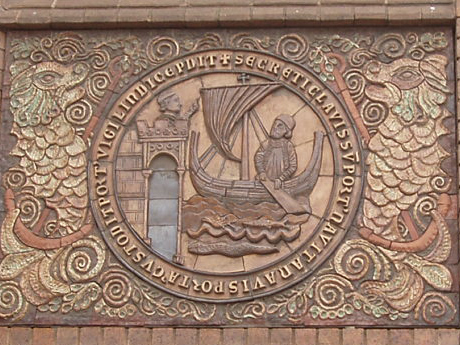 Secreti clavis sv port' navita navis porta' cvstodit port' vigil indice pdit
Secreti clavis sv port' navita navis porta' cvstodit port' vigil indice pdit
I am the key of the secret port. The pilot steers the helm of the ship. The warden points out the point with his forefinger
This is apparently the seal of the City of Bristol from 1300. The text around the seal supposedly refers to a secret entrance from the Avon to the castle moat, which seems an odd thing to advertise on your civic seal.
 No text to explain the image of two dragons locked in an earbiting fight.
No text to explain the image of two dragons locked in an earbiting fight.
It might be a reference to the Arthurian legend of Merlin revealing a pair of fighting dragons upsetting Vortigern's tower, but it's pretty obscure.
Update : The two dragons are from a 13th or 14th century roof boss from the bombed-out church of Saint Nicholas.
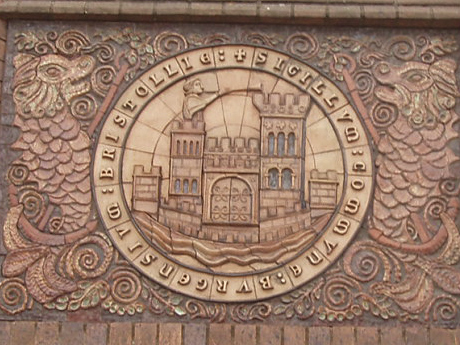 Sigillum : Commune : Burgensium : Bristollie
Sigillum : Commune : Burgensium : Bristollie
Seal of the community of the burgesses of Bristol
This makes a pair with the first panel, showing the front of the seal of the city. This seems to be Bristol Castle, demolished after the Civil War.
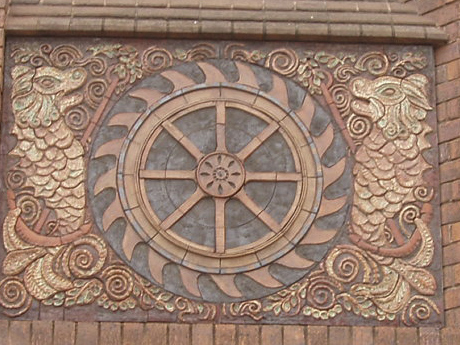 No text to explain a wheel with extra bits on.
No text to explain a wheel with extra bits on.
Possibly a waterwheel, with the 'teeth' actually the buckets for the water; there must have been a watermill in Bristol at some point.
Update : This is St Katherine's Wheel, which was the badge of Bristol's guild of Weavers.
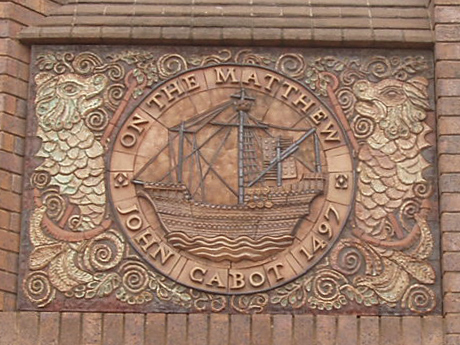 ¤ On the Matthew ¤ John Cabot 1497
¤ On the Matthew ¤ John Cabot 1497
In 1497 John Cabot (a citizen of Venice from Genoa) left Bristol in a Bristol-built ship, the Matthew, discovered Newfoundland, and returned to Bristol. There's a replica of the Matthew moored in the Floating Harbour now.
Mr Monkey visited the Matthew in March, 2006
 ~ Ye Parrish Church of St. Marie Redcliffe ~ The fairest goodliest and most famous parrish church in England
~ Ye Parrish Church of St. Marie Redcliffe ~ The fairest goodliest and most famous parrish church in England
St. Mary Redcliffe church as depicted on James Millerd's Exact Delineation of the Famous Citty of Bristoll and Suburbs of 1673.
The text around the roundel is Queen Elizabeth I's description of the church, after she'd visited Bristol in 1574.
You can see the whole map at the Great Reading Adventure 2008 website.
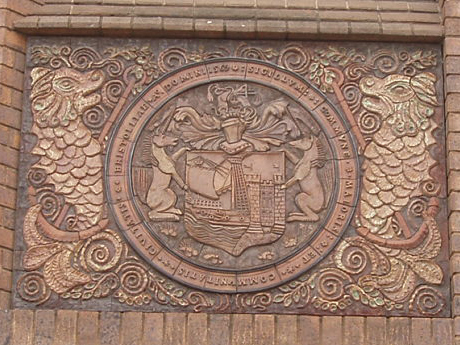 This roundel shows the arms of the City of Bristol.
This roundel shows the arms of the City of Bristol.
There's a colour picture and a heraldic description of the coat of arms at the Civic Heraldry website
 Civitas Bristoll Reducta 1643
Civitas Bristoll Reducta 1643
The most notable thing to happen to Bristol in 1643 was the Parliamentary forces inside the city surrendering to the Royalist forces besieging it, so it's reasonable to assume that this roundel has something to do with the siege.
It's hard to see exactly what, as nothing is on fire, or being knocked down, and no soldiers are running about. The slightly zig-zagged wall at the bottom could be the temporary defensive fieldworks thrown up to defend the city.
You can read about Bristol's Civil War fortifications at the Fortified Places website.
Update : This design is based on a coin struck in the city during the siege.
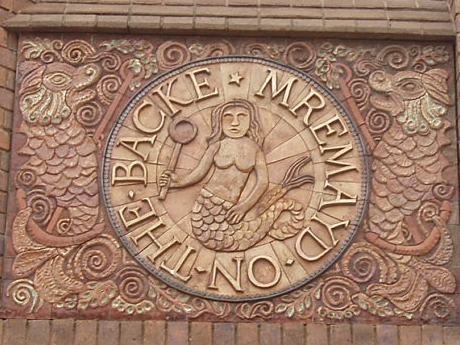 Mremayd on the Back
Mremayd on the Back
The only reference to a mermaid we can find is that there was a Bristol slave ship called the Mermaid, but that would be an obscure and unpleasant thing to comemmerate.
It's difficult to believe that they meant to put MREMAYD instead of MERMAYD, isn't it?
Update : This is a trade token issued by a public house, the Mermayd on the Backe (which had problems spelling it's own name).
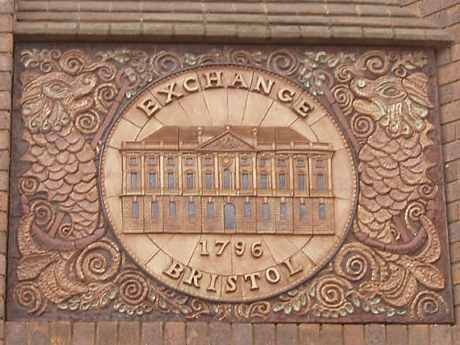 Exchange Bristol 1796
Exchange Bristol 1796
The Bristol Exchange, the only surviving 18th century Exchange building in England. The design appears to be based on a Conder halfpenny from Bristol.
Conder coins were minted by towns and businesses in the 16th and 17th centuries to make up for the government mints not producing enough low denomination coinage.
The Bristol Exchange was built between 1741 and 1743; the rather misleading date 1796 is the year the coin that inspired the roundel was minted.
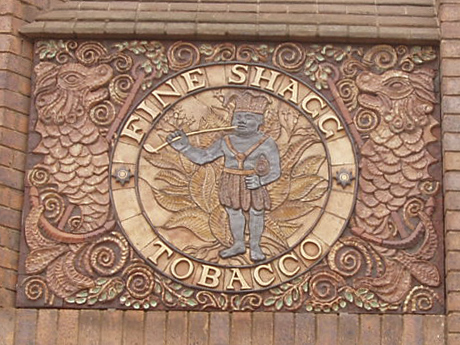 Fine shagg tobacco
Fine shagg tobacco
A tobacconist's wooden figure of an African, circa 1750, in front of a tobacco plant.
You can see the original figure at the Port Cities Bristol website.
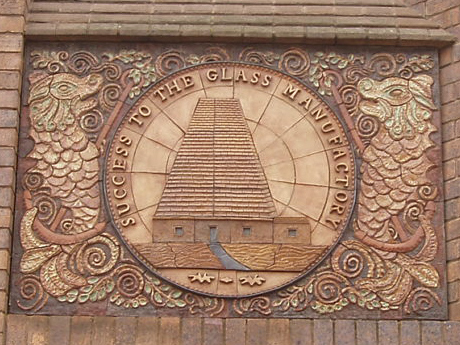 Success to the glass manufactory
Success to the glass manufactory
One of the glass kilns used in Bristol's glass industry in the 18th and 19th centuries. The design appears to be based on an undated Conder halfpenny from Bristol.
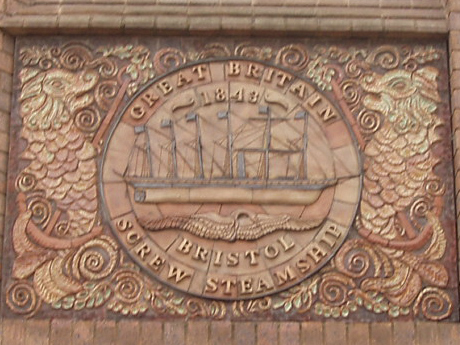 Great Britain. Screw steamship. 1843 Bristol
Great Britain. Screw steamship. 1843 Bristol
Isambard Kingdom Brunel built his steamship, the Great Britain, in Bristol in 1843. When it was finished in 1844 everyone noticed that the locks in the Cumberland Basin weren't wide enough and they had to be rebuilt so that the ship could leave Bristol. It's on display in a dry dock now.
Mr Monkey visited the Great Britain in March, 2006
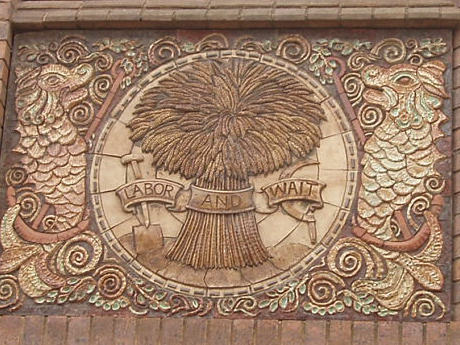 Labor and Wait
Labor and Wait
A wheatsheaf with a spade, a sickle, and the motto Labor and Wait.
The wheatsheaf and the motto Labor and Wait is a symbol of the Co-operative society. Apparently labour was deliberately spelt in the American manner to express support for American anti-slavery campaigners.
Update : Broad Quay House is on the site of the old headquarters of the Bristol Cooperative Society.
 No caption on the panel to explain it, but it could be a stylised image of a jet engine. If so, the panel probably refers to the Concorde. The first British-built Concorde, number 002, started her maiden flight from Bristol's Filton airfield on April 9, 1969.
No caption on the panel to explain it, but it could be a stylised image of a jet engine. If so, the panel probably refers to the Concorde. The first British-built Concorde, number 002, started her maiden flight from Bristol's Filton airfield on April 9, 1969.
Of course, it could be something else entirely.
Update : This is the jet intake of a Concorde, and Mr Monkey was right.
You read all about the murals made by Philippa Threlfall and Kennedy Collings at the Philippa Threlfall website.
Return to Mr Monkey in Bristol
Copyright Rik Shepherd and Mr Monkey.